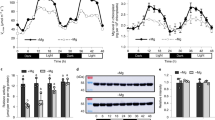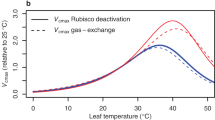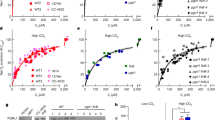Abstract
Most plants, contrary to popular belief, do not waste over 30% of their photosynthate in a futile cycle called photorespiration. Rather, the photorespiratory pathway generates additional malate in the chloroplast that empowers many energy-intensive chemical reactions, such as those involved in nitrate assimilation. Thus, the balance between carbon fixation and photorespiration determines the plant carbon–nitrogen balance and protein concentrations. Plant protein concentrations, in turn, depend not only on the relative concentrations of carbon dioxide and oxygen in the chloroplast but also on the relative activities of magnesium and manganese, which are metals that associate with several key enzymes in the photorespiratory pathway and alter their function. Understanding the regulation of these processes is critical for sustaining food quality under rising CO2 atmospheres.
This is a preview of subscription content, access via your institution
Access options
Access Nature and 54 other Nature Portfolio journals
Get Nature+, our best-value online-access subscription
$29.99 / 30 days
cancel any time
Subscribe to this journal
Receive 12 digital issues and online access to articles
$119.00 per year
only $9.92 per issue
Buy this article
- Purchase on Springer Link
- Instant access to full article PDF
Prices may be subject to local taxes which are calculated during checkout





Similar content being viewed by others
References
Raven, J. A. Rubisco: still the most abundant protein of Earth? New Phytol. 198, 1–3 (2013).
Foyer, C. H., Bloom, A. J., Queval, G. & Noctor, G. Photorespiratory metabolism: genes, mutants, energetics, and redox signaling. Annu. Rev. Plant Biol. 60, 455–484 (2009).
Walker, B. J., VanLoocke, A., Bernacchi, C. J. & Ort, D. R. The costs of photorespiration to food production now and in the future. Annu. Rev. Plant Biol. 67, 107–129 (2016).
Betti, M. et al. Manipulating photorespiration to increase plant productivity: recent advances and perspectives for crop improvement. J. Exp. Bot. 67, 2977–2988 (2016).
Ort, D. R. et al. Redesigning photosynthesis to sustainably meet global food and bioenergy demand. Proc. Natl Acad. Sci. USA 112, 8529–8536 (2015).
Shih, P. M. et al. Biochemical characterization of predicted Precambrian RuBisCO. Nat. Commun. 7, 10382 (2016).
Tabita, F. R., Satagopan, S., Hanson, T. E., Kreel, N. E. & Scott, S. S. Distinct form I, II, III, and IV Rubisco proteins from the three kingdoms of life provide clues about Rubisco evolution and structure/function relationships. J. Exp. Bot. 59, 1515–1524 (2008).
Miziorko, H. M. & Sealy, R. C. Characterization of the ribulosebisphosphate carboxylase–carbon dioxide–divalent cation–carboxypentitol bisphosphate complex. Biochemistry 19, 1167–1171 (1980).
Pierce, J. & Reddy, G. S. The sites for catalysis and activation of ribulosebisphosphate carboxylase share a common domain. Arch. Biochem. Biophys. 245, 483–493 (1986).
Bracher, A., Whitney, S. M., Hartl, F. U. & Hayer-Hartl, M. Biogenesis and metabolic maintenance of Rubisco. Annu. Rev. Plant Biol. 68, 29–60 (2017).
Tcherkez, G. The mechanism of Rubisco‐catalysed oxygenation. Plant Cell Environ. 39, 983–997 (2016).
Ogawa, S., Suzuki, Y., Yoshizawa, R., Kanno, K. & Makino, A. Effect of individual suppression of RBCS multigene family on Rubisco contents in rice leaves. Plant Cell Environ. 35, 546–553 (2012).
Aigner, H. et al. Plant RuBisCo assembly in E. coli with five chloroplast chaperones including BSD2. Science 358, 1272–1278 (2017).
Chollet, R. & Anderson, L. L. Regulation of ribulose 1,5-bisphosphate carboxylase–oxygenase activities by temperature pretreatment and chloroplast metabolites. Arch. Biochem. Biophys. 176, 344–351 (1976).
Chu, D. K. & Bassham, J. A. Activation of ribulose 1,5-diphosphate carboxylase by nicotinamide adenine-dinucleotide phosphate and other chloroplast metabolites. Plant Physiol. 54, 556–559 (1974).
Matsumura, H. et al. Crystal structure of rice Rubisco and implications for activation induced by positive effectors NADPH and 6-phosphogluconate. J. Mol. Biol. 422, 75–86 (2012).
McCurry, S. D., Pierce, J., Tolbert, N. E. & Orme-Johnson, W. H. On the mechanism of effector-mediated activation of ribulose bisphosphate carboxylase/oxygenase. J. Biol. Chem. 256, 6623–6628 (1981).
Bloom, A. J. Photorespiration and nitrate assimilation: a major intersection between plant carbon and nitrogen. Photosynth. Res. 123, 117–128 (2015).
Bloom, A. J. & Kameritsch, P. Relative association of Rubisco with manganese and magnesium as a regulatory mechanism in plants. Physiol. Plant. 161, 545–559 (2017).
Mogel, S. N. & McFadden, B. A. Chemiluminescence of the Mn2+-activated ribulose-1,5-bisphosphate oxygenase reaction: evidence for singlet oxygen production. Biochemistry 29, 8333–8337 (1990).
Lilley, R. M. C., Wang, X. Q., Krausz, E. & Andrews, T. J. Complete spectra of the far-red chemiluminescence of the oxygenase reaction of Mn2+-activated ribulose-bisphosphate carboxylase/oxygenase establish excited Mn2+ as the source. J. Biol. Chem. 278, 16488–16493 (2003).
Frank, J., Kositza, M. J., Vater, J. & Holzwarth, J. F. Microcalorimetric determination of the reaction enthalpy changes associated with the carboxylase and oxygenase reactions catalysed by ribulose 1,5-bisphosphate carboxylase/oxygenase (Rubisco). Phys. Chem. Chem. Phys. 2, 1301–1304 (2000).
Alberty, R. A. Calculation of standard transformed Gibbs energies and standard transformed enthalpies of biochemical reactants. Arch. Biochem. Biophys. 353, 116–130 (1998).
Günther, T. Concentration, compartmentation and metabolic function of intracellular free Mg2+. Magnes. Res. 19, 225–236 (2006).
Golynskiy, M. V., Gunderson, W. A., Hendrich, M. P. & Cohen, S. M. Metal binding studies and EPR spectroscopy of the manganese transport regulator MntR. Biochemistry 45, 15359–15372 (2006).
Arslan, P., Di Virgilio, F., Beltrame, M., Tsien, R. & Pozzan, T. Cytosolic Ca2+ homeostasis in Ehrlich and Yoshida carcinomas. A new, membrane-permeant chelator of heavy metals reveals that these ascites tumor cell lines have normal cytosolic free Ca2+. J. Biol. Chem. 260, 2719–2727 (1985).
Bloom, A. J. The increasing importance of distinguishing among plant nitrogen sources. Curr. Opin. Plant Biol. 25, 10–16 (2015).
Bloom, A. J. in Plant Physiology (eds Taiz, L. et al.) 353–376 (Sinauer, Sunderland, MA, 2015).
Dortch, Q. The interaction between ammonium and nitrate uptake in phytoplankton. Mar. Ecol. Prog. Ser. 61, 183–201 (1990).
Hodge, A., Helgason, T. & Fitter, A. H. Nutritional ecology of arbuscular mycorrhizal fungi. Fungal Ecol. 3, 267–273 (2010).
Ohashi, Y. et al. Regulation of nitrate assimilation in cyanobacteria. J. Exp. Bot. 62, 1411–1424 (2011).
Luque Almagro, V. M. et al. Bacterial nitrate assimilation: gene distribution and regulation. Biochem. Soc. Trans. 39, 1838–1843 (2011).
Britto, D. T. & Kronzucker, H. J. Ecological significance and complexity of N-source preference in plants. Ann. Bot. 112, 957–963 (2013).
Näsholm, T., Kielland, K. & Ganeteg, U. Uptake of organic nitrogen by plants. New Phytol. 182, 31–48 (2009).
Kuzyakov, Y. & Xu, X. Competition between roots and microorganisms for nitrogen: mechanisms and ecological relevance. New Phytol. 198, 656–669 (2013).
Jones, D. L., Clode, P. L., Kilburn, M. R., Stockdale, E. A. & Murphy, D. V. Competition between plant and bacterial cells at the microscale regulates the dynamics of nitrogen acquisition in wheat (Triticum aestivum). New Phytol. 200, 796–807 (2013).
Matson, P. A., Naylor, R. & Ortiz-Monasterio, I. Integration of environmental, agronomic, and economic aspects of fertilizer management. Science 280, 112–115 (1998).
Stark, J. M. & Hart, S. C. High rates of nitrification and nitrate turnover in undisturbed coniferous forests. Nature 385, 61–64 (1997).
Cabeza, R. et al. An RNA sequencing transcriptome analysis reveals novel insights into molecular aspects of the nitrate impact on the nodule activity of Medicago truncatula. Plant Physiol. 164, 400–411 (2014).
Bloom, A. J., Caldwell, R. M., Finazzo, J., Warner, R. L. & Weissbart, J. Oxygen and carbon dioxide fluxes from barley shoots depend on nitrate assimilation. Plant Physiol. 91, 352–356 (1989).
Bloom, A. J., Sukrapanna, S. S. & Warner, R. L. Root respiration associated with ammonium and nitrate absorption and assimilation by barley. Plant Physiol. 99, 1294–1301 (1992).
Cousins, A. B. & Bloom, A. J. Oxygen consumption during leaf nitrate assimilation in a C3 and C4 plant: the role of mitochondrial respiration. Plant Cell Environ. 27, 1537–1545 (2004).
Rubio-Asensio, J. S., Rachmilevitch, S. & Bloom, A. J. Responses of Arabidopsis and wheat to rising CO2 depend on nitrogen source and nighttime CO2 levels. Plant Physiol. 168, 156–163 (2015).
Scheibe, R. Malate valves to balance cellular energy supply. Physiol. Plant 120, 21–26 (2004).
Obata, T., Florian, A., Timm, S., Bauwe, H. & Fernie, A. R. On the metabolic interactions of (photo) respiration. J. Exp. Bot. 67, 3003–3014 (2016).
Backhausen, J. E. et al. Transgenic potato plants with altered expression levels of chloroplast NADP–malate dehydrogenase: interactions between photosynthetic electron transport and malate metabolism in leaves and in isolated intact chloroplasts. Planta 207, 105–114 (1998).
Taniguchi, M. & Miyake, H. Redox-shuttling between chloroplast and cytosol: integration of intra-chloroplast and extra-chloroplast metabolism. Curr. Opin. Plant Biol. 15, 252–260 (2012).
Voss, I., Sunil, B., Scheibe, R. & Raghavendra, A. S. Emerging concept for the role of photorespiration as an important part of abiotic stress response. Plant Biol. 15, 713–722 (2013).
Dutilleul, C. et al. Mitochondria-driven changes in leaf NAD status exert a crucial influence on the control of nitrate assimilation and the integration of carbon and nitrogen metabolism. Plant Physiol. 139, 64–78 (2005).
Schneidereit, J., Hausler, R. E., Fiene, G., Kaiser, W. M. & Weber, A. P. M. Antisense repression reveals a crucial role of the plastidic 2-oxoglutarate/malate translocator DiT1 at the interface between carbon and nitrogen metabolism. Plant J. 45, 206–224 (2006).
Bloom, A. J., Smart, D. R., Nguyen, D. T. & Searles, P. S. Nitrogen assimilation and growth of wheat under elevated carbon dioxide. Proc. Natl Acad. Sci. USA 99, 1730–1735 (2002).
Rachmilevitch, S., Cousins, A. B. & Bloom, A. J. Nitrate assimilation in plant shoots depends on photorespiration. Proc. Natl Acad. Sci. USA 101, 11506–11510 (2004).
Loladze, I. Hidden shift of the ionome of plants exposed to elevated CO2 depletes minerals at the base of human nutrition. eLife 3, e02245 (2014).
Montes-Bayón, M., Blanco-González, E. & Michalke, B. in Metallomics (ed. Michalke, B.) Ch. 12 (Wiley, Weinheim, 2016).
Foster, A. W., Osman, D. & Robinson, N. J. Metal preferences and metallation. J. Biol. Chem. 289, 28095–28103 (2014).
Dudev, T. & Lim, C. Competition among metal ions for protein binding sites: determinants of metal ion selectivity in proteins. Chem. Rev. 114, 538–556 (2013).
Lothian, A. et al. Metalloproteomics: principles, challenges and applications to neurodegeneration. Front. Aging Neurosci. 5, 35 (2013).
Bock, C. W., Katz, A. K., Markham, G. D. & Glusker, J. P. Manganese as a replacement for magnesium and zinc: functional comparison of the divalent ions. J. Am. Chem. Soc. 121, 7360–7372 (1999).
Andrews, T. J. & Kane, H. J. Pyruvate is a by-product of catalysis by ribulosebisphosphate carboxylase/oxygenase. J. Biol. Chem. 266, 9447–9452 (1991).
Brown, D. A. & Cook, R. A. Role of metal cofactors in enzyme regulation. Differences in the regulatory properties of the Escherichia coli nicotinamide adenine dinucleotide phosphate-specific malic enzyme, depending on whether magnesium ion or manganese (2+) ion serves as divalent cation. Biochemistry 20, 2503–2512 (1981).
Artus, N. & Edwards, G. NAD–malic enzyme from plants. FEBS Lett. 182, 225–233 (1985).
Chang, G.-G. & Tong, L. Structure and function of malic enzymes, a new class of oxidative decarboxylases. Biochemistry 42, 12721–12733 (2003).
Wheeler, M. C. G. et al. Arabidopsis thaliana NADP–malic enzyme isoforms: high degree of identity but clearly distinct properties. Plant Mol. Biol. 67, 231–242 (2008).
Müller, G. L., Drincovich, M. F., Andreo, C. S. & Lara, M. V. Nicotiana tabacum NADP–malic enzyme: cloning, characterization and analysis of biological role. Plant Cell Physiol. 49, 469–480 (2008).
Husic, H. D. & Tolbert, N. Anion and divalent cation activation of phosphoglycolate phosphatase from leaves. Arch. Biochem. Biophys. 229, 64–72 (1984).
Kim, Y. et al. Structure- and function-based characterization of a new phosphoglycolate phosphatase from Thermoplasma acidophilum. J. Biol. Chem. 279, 517–526 (2004).
Ehleringer, J. R., Cerling, T. E. & Helliker, B. R. C4 photosynthesis, atmospheric CO2, and climate. Oecologia 112, 285–299 (1997).
Collatz, G. J., Berry, J. A. & Clark, J. S. Effects of climate and atmospheric CO2 partial pressure on the global distribution of C4 grasses: present, past, and future. Oecologia 114, 441–454 (1998).
Skillman, J. B. Quantum yield variation across the three pathways of photosynthesis: not yet out of the dark. J. Exp. Bot. 59, 1647–1661 (2008).
Galmés, J. et al. Expanding knowledge of the Rubisco kinetics variability in plant species: environmental and evolutionary trends. Plant Cell Environ. 37, 1989–2001 (2014).
Tcherkez, G. G. B., Farquhar, G. D. & Andrews, T. J. Despite slow catalysis and confused substrate specificity, all ribulose bisphosphate carboxylases may be nearly perfectly optimized. Proc. Natl Acad. Sci. USA 103, 7246–7251 (2006).
Busch, F. A., Sage, R. F. & Farquhar, G. D. Plants increase CO2 uptake by assimilating nitrogen via the photorespiratory pathway. Nat. Plants 4, 46–54 (2018).
Silva‐Pérez, V., Furbank, R. T., Condon, A. G. & Evans, J. R. Biochemical model of C3 photosynthesis applied to wheat at different temperatures. Plant Cell Environ. 40, 1552–1564 (2017).
Walker, B. J. et al. Uncertainty in measurements of the photorespiratory CO2 compensation point and its impact on models of leaf photosynthesis. Photosynth. Res. 132, 245–255 (2017).
Luomala, E., Laitinen, K., Sutinen, S., Kellomäki, S. & Vapaavuori, E. Stomatal density, anatomy and nutrient concentrations of Scots pine needles are affected by elevated CO2 and temperature. Plant Cell Environ. 28, 733–749 (2005).
Hermida-Carrera, C., Kapralov, M. V. & Galmés, J. Rubisco catalytic properties and temperature response in crops. Plant Physiol. 171, 2549–2561 (2016).
Bauwe, H. in C 4 Photosynthesis and Related CO 2 Concentrating Mechanisms (eds Raghavendra, A. S. & Sage, R. F.) 81–108 (Springer, Dordrecht, 2010).
Khoshravesh, R. et al. C3–C4 intermediacy in grasses: organelle enrichment and distribution, glycine decarboxylase expression, and the rise of C2 photosynthesis. J. Exp. Bot. 67, 3065–3078 (2016).
Creutz, C. & Sutin, N. Reaction of tris (bipyridine) ruthenium (III) with hydroxide and its application in a solar energy storage system. Proc. Natl Acad. Sci. USA 72, 2858–2862 (1975).
Bock, C. et al. Estimation of excited-state redox potentials by electron-transfer quenching. Application of electron-transfer theory to excited-state redox processes. J. Am. Chem. Soc. 101, 4815–4824 (1979).
Sattler, W. et al. Generation of powerful tungsten reductants by visible light excitation. J. Am. Chem. Soc. 135, 10614–10617 (2013).
Brautigam, C. A., Zhao, H., Vargas, C., Keller, S. & Schuck, P. Integration and global analysis of isothermal titration calorimetry data for studying macromolecular interactions. Nat. Protoc. 11, 882–894 (2016).
Bloom, A. J., Burger, M., Asensio, J. S. R. & Cousins, A. B. Carbon dioxide enrichment inhibits nitrate assimilation in wheat and Arabidopsis. Science 328, 899–903 (2010).
Dukes, J. S. et al. Responses of grassland production to single and multiple global environmental changes. PLoS Biol. 3, 1829–1837 (2005).
Rasse, D. P., Peresta, G. & Drake, B. G. Seventeen years of elevated CO2 exposure in a Chesapeake Bay Wetland: sustained but contrasting responses of plant growth and CO2 uptake. Glob. Chang. Biol. 11, 369–377 (2005).
Kimball, B. A., Idso, S. B., Johnson, S. & Rillig, M. C. Seventeen years of carbon dioxide enrichment of sour orange trees: final results. Glob. Chang. Biol. 13, 2171–2183 (2007).
Norby, R. J., Warren, J. M., Iversen, C. M., Medlyn, B. E. & McMurtrie, R. E. CO2 enhancement of forest productivity constrained by limited nitrogen availability. Proc. Natl Acad. Sci. USA 107, 19368–19373 (2010).
Talhelm, A. F. et al. Elevated carbon dioxide and ozone alter productivity and ecosystem carbon content in northern temperate forests. Glob. Chang. Biol. 20, 2492–2504 (2014).
Schäfer, K. V. R. et al. Exposure to an enriched CO2 atmosphere alters carbon assimilation and allocation in a pine forest ecosystem. Global Change Biol. 9, 1378–1400 (2003).
Körner, C. et al. Carbon flux and growth in mature deciduous forest trees exposed to elevated CO2. Science 309, 1360–1362 (2005).
Myers, S. S. et al. Increasing CO2 threatens human nutrition. Nature 510, 139–142 (2014).
Acknowledgements
This work was funded by NSF grants IOS-16-55810 and IOS-13-58675, USDA-IWYP-16-06702 and the John B. Orr Endowment. We thank F. Fox for his comments on the manuscript.
Author information
Authors and Affiliations
Contributions
A.J.B. wrote most of the manuscript. K.M.L. contributed the section on the chemistry of Mn2+ electron transfers and helped to edit the entire manuscript.
Corresponding author
Ethics declarations
Competing interests
The authors declare no competing interests.
Additional information
Publisher’s note: Springer Nature remains neutral with regard to jurisdictional claims in published maps and institutional affiliations.
Rights and permissions
About this article
Cite this article
Bloom, A.J., Lancaster, K.M. Manganese binding to Rubisco could drive a photorespiratory pathway that increases the energy efficiency of photosynthesis. Nature Plants 4, 414–422 (2018). https://doi.org/10.1038/s41477-018-0191-0
Received:
Accepted:
Published:
Issue Date:
DOI: https://doi.org/10.1038/s41477-018-0191-0
This article is cited by
-
Importance of Manganese-Based Advanced Nanomaterial for Foliar Application
Journal of Cluster Science (2024)
-
Study of vacuole glycerate transporter NPF8.4 reveals a new role of photorespiration in C/N balance
Nature Plants (2023)
-
Role of Beneficial Elements in Developing Resilience to Abiotic and Biotic Stresses in Plants: Present Status and Future Prospects
Journal of Plant Growth Regulation (2023)
-
Soil Arbuscular Mycorrhizal Fungal Communities Differentially Affect Growth and Nutrient Uptake by Grapevine Rootstocks
Microbial Ecology (2023)
-
Roles of stomata in gramineous crops growth and biomass production
Cereal Research Communications (2022)



